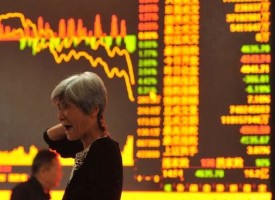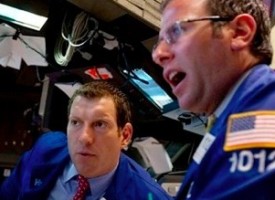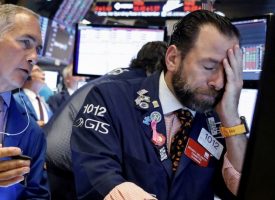Here is the setup as we kickoff 2022…
January 1 (King World News) – Alasdair Macleod: Following the Lehman crisis, it became fashionable to cite the Triffin dilemma as justification for inflationary US policies and why they would not undermine the US dollar in the foreign exchanges.
But far from being simply a justification for continual dollar trade deficits, Triffin correctly described a situation which was bound to lead to problems for a reserve currency. This article describes how his analysis was borne out by events during the Bretton Woods Agreement, and the lessons that can be learned from it with respect to the current situation facing the US dollar.
Introduction
In the years following the Lehman crisis, it became popular to refer to the Triffin dilemma. Commentators usually invoked it as an explanation of a strong dollar despite a worsening trade deficit and even for the encouragement of more dollar inflation to satisfy foreign demand. According to Triffin, being the reserve currency and the medium for pricing commodities and international trade, foreigners always needed dollars. Therefore, the US could continue to run a trade deficit without damaging the exchange rate.
At that time, the world was recovering from what many economists have since named as the great financial crisis. It originated in the US residential property market which had boomed on the back of unfettered bank credit expansion and a growing alphabet soup of collateralisations. Central banks, who were meant to be the ringmasters controlling the expansion of banking activities were caught unexpectedly and disgracefully unaware of the expansion of off-balance sheet bank lending. And their understanding of the dangers of securitisations of securitisations of liar loans upon which the marginal pricing of residential property depended was sadly lacking.
When the music stopped, a new dollar number came into common parlance — the trillion. Until then we looked at the emergence of billions in the financial lexicon in the early noughties with some awe. Now the Fed was writing open cheques, potentially in the trillions just so that the inflated financial system, the counterpart of credit loaned to people who could not afford to buy the property assets securitising the whole kaboodle, would not collapse. The Fed printing dollars without limitation meant that Lehman was the only significant American bank to go under.
Other central banks were less fortunate in their policy outcomes. Eurozone member states had given up their monetary seigniorage to the ECB, so whole countries had to be bailed out — Ireland, Cyprus, Greece, Italy, Spain, and Portugal. BAFIN, Germany’s banking regulator turned a blind eye to the true condition of its banks, and the large private banks (Deutsche and Commerzbank) are still struggling today.
In the years following the crisis, Triffin was like a comfort blanket for those of us who turned a blind eye to all the currency expansion in the wake of it. It justified the Fed’s extraordinary new measures, such as quantitative easing, without having to worry about the consequences. The Fed therefore could and should expand its balance sheet to unprecedented levels, because foreigners needed the dollars to grow their economies out of crisis. But we were ignoring the second part of Triffin’s dilemma: those consequences…
To find out which silver company just made a major acquisition that will
quadruple their production click here or on the image below

What is the Triffin dilemma?
Let us get it from the horse’s mouth. The following is extracted from the IMF’s website:
“Testifying before the US Congress in 1960, economist Robert Triffin exposed a fundamental problem in the international monetary system.
If the Untied States stopped running balance of payments deficits, the international community would lose its largest source of additions to reserves. The resulting shortage of liquidity could pull the world economy into a contractionary spiral, leading to instability.
If U.S. deficits continued, a steady stream of dollars would continue to fuel world economic growth. However, excessive U.S. deficits (dollar glut) would erode confidence in the value of the U.S. dollar. Without confidence in the dollar, it would no longer be accepted as the world’s reserve currency. The fixed exchange rate system could break down, leading to instability.”
In other words, for the dollar to function as the world’s reserve currency and to be used as the currency for international trade, the US Fed and Treasury must run their monetary policies and the economy in such a way as to create dollars for export to foreign ownership. A continual US deficit on the balance of trade, which in the absence of an increase in the savings rate requires a continual increase in the budget deficit, is the principal means of production of those dollars. These policies are obviously inflationary at the monetary level, any negative effect hidden from producer and consumer prices by the demand for dollars leading to the maintenance of their purchasing power.
But it is a balancing act. Too much currency inflation created by a deliberate increase in the trade deficit risks eroding confidence in the currency, leading to its purchasing power being undermined. That is one side of the coin. The other, not mentioned by Triffin, comes from the dollar’s foreign users. Unless the American authorities have the means and the will to balance the quantities of dollars exported with accurately forecast foreign demand for them, a policy of supplying dollars for international purposes would be bound to fail at the first global economic downturn.
For example, if foreign demand for dollars was to fall, then the US should reduce the quantity of dollars exported by raising domestic taxes to reduce the budget deficit and therefore the trade deficit. Alternatively, saving by US consumers would have to be encouraged to reduce immediate demand for foreign goods, either by encouraging saving through tax breaks or by raising interest rates on deposit accounts to discourage spending.
Immediately we can see problems with these solutions. If the level of foreign demand for dollars falls, it is likely due to the onset of a global recession, and policy advice would almost certainly be to stimulate demand to prevent a global recession impacting on the US economy. Reducing the dollars in circulation to maintain its purchasing power would be seen to be counterproductive to the Keynesians who would argue that monetary stimulus should be increased instead to counter a recession.
As for tax breaks for savers or the supposed benefits to them of higher interest rates on their bank deposits, these are no-go areas for economic and monetary policies as well, again for Keynesian reasons. Triffin’s recommended solution was as follows:
“Triffin proposed the creation of new reserve units. These units would not depend on gold or currencies but would add to the world’s total liquidity. Creating such a new reserve would allow the United States to reduce its balance of payments deficits, while still allowing for global economic expansion.”
In other words, he proposed something along the lines of Keynes’s bancor which was rejected in favour of the dollar by the Bretton Woods Agreement. In fact, Triffin’s underlying approach was as inflationary as anything Keynes proposed in the 1940s, and his assumption that the world could not do without an expanding reserve currency, a situation thought to lead to economic and price stability, was similarly questionable. But Triffin’s prediction that the fixed exchange rate system backed by the dollar as reserve currency could break down was obviously correct and borne out by events…
Keith Neumeyer Just Predicted $100+ Silver And $3,000 Gold! TO LISTEN CLICK HERE OR ON THE IMAGE BELOW.
The dollar’s failure in the 1960s
Following his US Congress testimony, Triffin’s forecast was confirmed by events later in the decade by the failure of the London gold pool. The background that led up to it was excess inflation of the dollar and a trend of bank credit expansion financing US corporate growth abroad in the post-war years.
Economic and monetary stability were particularly undermined by the Vietnam war. The productive economy became heavily slanted towards military production and away from the goods and services genuinely demanded by the American consumer. The war in Vietnam particularly led to the export of cash dollars in large quantities. From 1954 onwards, America became increasingly bogged down in Vietnam, so by the mid-1960s, there had been over ten years of increasing dollar cash exports due to that war alone.
The Vietnam war was fought in what previously had been French Indochina, so it was natural for legacy French interests to end up with unwanted dollars. And it was France under President de Gaulle, advised by Jacques Rueff, which led the repatriation of these dollars in exchange for US gold in accordance with the terms of the Bretton Woods Agreement.
After the US’s gold reserves had fallen from 21,828 tonnes in 1949 to 15,060 tonnes in 1961, the London gold pool was set up to defend the $35 per ounce exchange rate. Seven European nations joined the US in keeping the gold price at $35, but still gold was lost to the markets. By 1968, when the arrangement failed, the US’s gold reserves had fallen to 9,679 tonnes, while the other participants had increased their gold reserves by 3,346 tonnes. The only central bank which supported the policy by its actions was the Bank of England, which under the agreement sold 868 tonnes. The others all went behind the US’s back to increase their gold reserves.
There is more honour among thieves than there appears to have been between the central banks which were members of the gold pool. It was hardly surprising that the arrangement failed, and that subsequently President Nixon suspended the Bretton Woods Agreement in 1971. It was the darker side of the Triffin dilemma: the pursuit of bad economic and monetary policies to ensure that there were enough dollars to satisfy global reserve requirements in the post-war years caused the dollar to devalue against gold from $35 to over $800 some nine years later. 1971 was also the first of the post-war years that the US suffered a deficit on the balance of payments, turning around a surplus of $2.331bn the previous year into a deficit of $1.433bn.
Triffin after Bretton Woods
Since the mid-seventies, the US balance of payments has deteriorated at an increased pace, ensuring the world has already become awash with dollars. The latest US Treasury TIC figures show foreign holdings of long-term securities now totals a record $26.865 trillion, to which can be added short-term securities and bank balances of $6.752 trillion for a combined total of $33.617 trillion.
Looking at these numbers in the context of Triffin tells us that with foreign cash and investments in US dollars now at about 150% of US GDP, there are probably too many dollars in foreign hands and a repeat of the conditions that led to the failure of the London gold pool in 1968 is now in place.
Following on from our analysis of the 1968 failure of the London gold pool, global demand for these dollars is likely to subside as the global economy stops growing, of which there is mounting evidence. The engine pulling the other foreign economies along has been China, which has been slowing in recent years and is now beset with a developing property crisis of its own, Evergrande potentially being a walking shadow of Lehman. And nearly all other governments in advanced nations are still prioritising Covid lockdowns over production, with supply chain issues continuing to disrupt trade.
At the same time, the Biden administration is increasing US government spending on the premise that it will be financed by taxes gained from soaking the rich and by stimulating economic recovery. Biden’s wish-list doubles down on neo-Keynesian fallacies of the past and will ensure that the production of dollars to end up in foreign hands will continue apace. Instead of reducing the supply of dollars to balance a fall in demand for them, the combination of a developing global recession and increasing US Government budget deficits is set to undermine the dollar’s exchange rate and/or its purchasing power. Due to economic stagnation, the flow of excess dollars out of foreign ownership is now set replicate the crisis of 1968, but in an entirely fiat currency context.
And now there is another spectre haunting us from the Keynesian past: increasing price inflation. There must be no doubt that stubbornly rising consumer prices will lead to interest rates in 2022 rising significantly from the lowest levels in the history of fiat currencies, ever…
VERY BIG DEAL!
This exploration company just made one of the biggest
acquisitions of 2021 that stunned investors!
To learn more click here or on the image below

The consequences of the developing Triffin crisis
Measured by the price of gold, that is to say real money and not currency, the dollar has already seen its purchasing power fall by over 98% (i.e. $35/$1800). The dollar’s fate has been broadly shared by all the other currencies which became purely fiat when the Bretton Woods Agreement was abandoned in 1971. But only now, the dark side of Triffin’s dilemma is about to hit a dollar and the other fiat currencies already badly undermined over the last fifty years. Furthermore, through the suppression of dollar interest rates at the zero bound, market values have become horribly distorted. Clearly, a rise in interest rates will result in a destabilising value shock in financial markets.
The ensuing bear market in US dollar investments will remove any reason for foreign holders to maintain investments in bonds, whose capital values are bound to fall, and in equities, where the motivation for excessive investment of some $14 trillion’s worth is essentially opportunistic. For foreigners, the only justifiable dollar holdings become strictly trade-related and for offshore insurance funds in Cayman and elsewhere maintaining reserves against potential onshore liabilities. The potential for selling of dollars by foreigners therefore appears to be substantial, leading to a potentially self-feeding collapse of financial asset valuations, irrespective of the actions of domestic American investors.
Therefore, the set-up for a significant bear market triggered by rising interest rates is almost certainly a set-up for a dollar collapse as well. But sellers of dollars are faced with the problem that their currencies are loosely tied to the dollar, and domestic conditions for foreigners make their currencies unattractive as well. Consequently, a dollar crisis is unlikely to be confined to the reserve currency, potentially undermining all other fiat currencies. The best escape route from a currency crisis appears to be to reduce exposure to all currencies in favour of goods and of true money — that is physical gold and silver.
The move out of currencies has already begun, as illustrated by the chart below.
Measured by this tracker fund, commodity prices have more than doubled since the Fed reduced its fund rate to the zero bound and instituted an inflationary QE, which has added over $2 trillion to the dollar’s circulating quantity. Rises in the general level of commodity prices has not been because of extra economic demand.
After significant increases in the prices of gold and silver between March and August 2020, since then gold and silver have broadly consolidated those gains. Consequently, over this year they have underperformed a basket of non-monetary commodities, consistent with a lack of contemporary understanding of the differences between money, currency, and bank credit…
Billionaire Eric Sprott bought a 20% stake in a mining company
to find out which one click here or on the image below

As the current fiat money crisis evolves, this underperformance is likely to be corrected. The situation could lead to a new attempt by leading central banks at a new gold suppression policy. In the face of failure, will they simply continue to insist that their fiat currencies are modern money and that gold and silver have no contemporary role in the monetary system? Or will they club together to suppress the evidence of gold’s superiority over fiat currency?
If they attempt the latter, the Americans and the British (who, incidentally, sold most of their gold at under $300), might find, yet again, that the major European national central banks use any such agreement to top up their reserves by buying gold from the Anglo-Saxons, just as they did in the 1960s.
Shock In 2022
ALSO RELEASED: Interest Rate Shock Will Rock Global Markets In 2022 CLICK HERE TO READ.
To listen to Alasdair Macleod discuss the setup for the gold and silver markets in 2022 CLICK HERE OR ON THE IMAGE BELOW.
© 2022 by King World News®. All Rights Reserved. This material may not be published, broadcast, rewritten, or redistributed. However, linking directly to the articles is permitted and encouraged.










